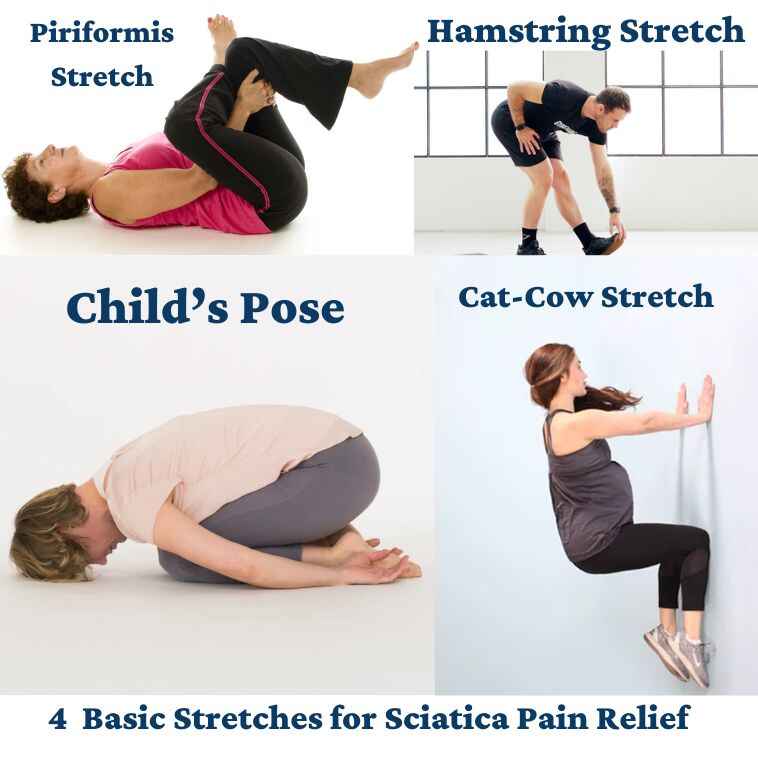
16 Best Stretching for Sciatica Pain Relief
Last updated on July 31st, 2025 at 10:01 pm
Sciatic nerve pain can be tough for people who experience it. Pain in the lower back that comes with sciatica can be very painful. The pain from sciatica can spread to other parts of the body. It can be hard to determine if your lower back and legs hurt from sciatica without talking to a doctor or physical therapist. Understanding the symptoms of sciatica and its main causes is very important to control pain effectively. Incorporating stretching for sciatica pain into your routine can help alleviate symptoms and manage discomfort.
Table of Contents
What is the Sciatic Nerve?
The sciatic nerve is a large nerve that starts from the lower backbone and extends down both legs. Pain from the sciatic nerve, known as sciatica, occurs when there is pressure on the nerve. Because of its length, pressure on the nerve can cause various types of pain in the lower back and legs.
Fortunately, relieving sciatic nerve pain can often be simpler than you might think. Different types of pain that occur due to pressure on nerves, like sciatica, are generally reduced when pressure on the sciatic nerve decreases.
For example, the piriformis muscle can cause initial discomfort as it stretches from the backbone to the upper leg. When the piriformis muscle is injured, swelling and a condition called piriformis syndrome can occur.
Treatment for sciatic nerve pain, like piriformis syndrome, usually involves physical therapy. Treatment frequently starts by stretching and strengthening the hip and buttock muscles. Many people affected by sciatica can reduce pain without medication or other medical interventions by reducing inflammation and pressure on the lower leg and backbone.
Causes of Sciatica
- Herniated Disc: Disc material presses on the sciatic nerve.
- Spinal Stenosis: Narrowing of the spinal canal compresses nerves.
- Degenerative Disc Disease: Wear and tear on discs can pinch nerves.
- Spondylolisthesis: Vertebrae slip, pressing on the sciatic nerve.
- Muscle Spasms: Tight muscles in the back or buttocks pinch the nerve.
- Injury: Trauma to the spine or buttocks irritates the nerve.
Read More: Can Sciatica Cause Groin Pain Best Guide
The Importance of Stretching for Sciatica Pain Relief
Stretching for sciatica pain is an important way to relieve discomfort and improve overall well-being. It helps to reduce muscle tension, improve flexibility, and promote better blood circulation. When muscles in the lower back, hips, and legs are less tight, there is less pressure on the sciatic nerve, which can help ease pain. Regular stretching for sciatica pain can also make you more flexible, preventing tightness that can worsen the condition. Better blood flow helps muscles heal and reduces inflammation. Stretching for sciatica pain also strengthens muscles, supports better posture, and can be a simple, effective part of your daily routine to manage discomfort. Always stretch gently and listen to your body to avoid overdoing it.
Precautions Before Starting Stretching Exercises
Before starting stretching exercises for sciatica pain, take some precautions to stay safe. First, consult a healthcare professional to ensure that stretching for sciatica pain is right for you. Warm up your muscles with light activity to prevent injury. Start slowly and gently, avoiding any sharp pain or bouncing movements. Use proper technique, breathe normally, and stay hydrated. Make sure you have enough space and use a comfortable surface. These steps will help you safely and effectively manage your sciatica pain with stretching.
Basic Stretches for Sciatica Pain Relief
Here are some basic stretches that can help relieve sciatica pain:

- Piriformis Stretch
- Sit on the floor with your legs extended. Cross one leg over the other, placing your foot flat on the floor. Gently pull the crossed knee towards your chest until you feel a stretch in your buttock. Hold for 30 seconds, then switch sides.
- Hamstring Stretch
- Lie on your back with one leg bent and the other leg straight. Lift the straight leg towards the ceiling, holding your thigh or calf. Keep your back flat on the floor and feel the stretch along the back of your leg. Hold for 30 seconds, then switch legs.
- Child’s Pose
- Kneel on the floor and sit back on your heels. Extend your arms forward and lower your chest towards the ground, feeling a gentle stretch in your lower back and hips. Hold for 30 seconds.
- Cat-Cow Stretch
- Get on your hands and knees. Arch your back (cat pose) and then lower your belly towards the floor while lifting your head (cow pose). Move slowly between these positions for 30 seconds to stretch and mobilize your spine.
These stretches can help reduce muscle tension and improve flexibility, providing relief from sciatica pain.
7. Advanced Stretches for Sciatica Pain Relief
For those who are comfortable with basic stretches and want to take their sciatica pain relief routine to the next level, here are some advanced stretches:

- Pigeon Pose
- Start on your hands and knees. Bring one knee forward and place it behind your wrist while extending the opposite leg straight back. Lower your hips toward the floor, feeling a deep stretch in your hips and glutes. Hold for 30 seconds, then switch sides.
- Reclining Hand-to-Big-Toe Pose (Supta Padangusthasana)
- Lie on your back with one leg extended on the floor. Use a strap or towel around the foot of the opposite leg and gently pull it towards you, keeping the leg straight. Feel the stretch in your hamstring and lower back. Hold for 30 seconds, then switch legs.
- Kneeling Lunge Stretch
- Kneel on one knee with the other foot in front, creating a 90-degree angle with both legs. Shift your weight forward slightly, feeling a stretch in the hip flexors of the back leg. Hold for 30 seconds, then switch legs.
- Seated Spinal Twist
- Sit on the floor with both legs extended. Bend one knee and place the foot outside the opposite thigh. Twist your torso towards the bent knee, using your opposite arm to gently press against the knee for a deeper stretch. Hold for 30 seconds, then switch sides.
- Double Pigeon Pose (Fire Log Pose)
- Sit on the floor and stack one shin on top of the other, with your feet flexed. Keep your back straight and hinge forward at the hips for a deeper stretch in the hips and glutes. Hold for 30 seconds, then switch sides.
- Wall Hamstring Stretch
- Lie on your back next to a wall. Extend one leg up against the wall while keeping the other leg flat on the floor. Adjust your position to feel a deep stretch in your hamstring. Hold for 30 seconds, then switch legs.
- Bridge Pose
- Lie on your back with your knees bent and feet flat on the floor, hip-width apart. Lift your hips towards the ceiling, engaging your glutes and core. Hold for 30 seconds, feeling a stretch in your lower back and hip flexors.
These advanced stretches target deeper muscles and can provide greater relief from sciatica pain. Always perform these stretches slowly and carefully, listening to your body to avoid overstraining.
Tips for Effective Stretching
To stretch effectively, always start with a light warm-up to get your muscles ready. When performing stretching for sciatica pain, do it regularly, holding each stretch for 20-30 seconds, and breathe deeply to help your muscles relax. Avoid bouncing, as it can cause injury, and stretch only to the point of mild tension, not pain. Stay hydrated, use proper technique, and create a comfortable space for stretching. Including a variety of stretches can help improve overall flexibility and manage sciatica pain more effectively.
Additional Therapies and Treatment Options for Sciatica Pain Relief
- Physical Therapy:
A customized physical therapy program can include exercises, stretches, and modalities to improve strength, flexibility, and posture, reducing sciatica symptoms.
Chiropractic adjustments can help realign the spine and alleviate pressure on the sciatic nerve, providing relief from pain and discomfort.
- Acupuncture:
Acupuncture involves inserting thin needles into specific points on the body to stimulate nerve pathways and release endorphins, offering natural pain relief for sciatica.
- Massage Therapy:
Massage therapy can help relax tight muscles, improve circulation, and reduce inflammation, providing relief from sciatica pain and promoting overall well-being.
Lifestyle Changes to Manage Sciatica Pain:
Living with sciatica pain requires making adjustments to your daily habits and routines. Here are some lifestyle changes that can help you effectively manage your symptoms:
- Proper Posture:
Maintaining good posture is essential for relieving pressure on the spine and reducing sciatica pain. When sitting or standing, keep your back straight, and shoulders relaxed, and distribute your weight evenly.
- Exercise Regularly:
Engaging in regular exercise can strengthen the muscles that support the spine, improve flexibility, and alleviate sciatica symptoms. Incorporate low-impact activities like walking, swimming, or yoga into your routine to help manage pain and prevent further discomfort.
- Maintain Healthy Weight:
Excess weight can exacerbate sciatica pain by putting added pressure on the spine and nerves. By maintaining a healthy weight through a balanced diet and regular exercise, you can reduce the strain on your back and decrease the severity of your symptoms.
- Use Proper Ergonomics:
Whether you’re sitting at a desk or lifting heavy objects, practicing proper ergonomics is crucial for preventing sciatica pain. Use supportive chairs with good lumbar support, adjust your workstation to promote neutral spine alignment, and lift objects using your legs instead of your back to avoid unnecessary strain.
FAQs
What is the miracle stretch for sciatica?
Lie on your back with your hands under your buttocks. Slowly straighten your arms so your upper body lifts while your hips stay in place. Hold this stretch for 10-15 seconds, feeling a gentle stretch in your lower back. Repeat this stretch 5-10 times as comfortable. This exercise helps relax your lower back, reducing pressure on the sciatic nerves and providing immediate relief from sciatica pain.
Can you get rid of sciatica by stretching?
Stretching can be very helpful because it reduces muscle tension and can also alleviate nerve pressure. It’s usually considered a crucial part of a complete treatment plan that may include physical therapy, medication, and lifestyle adjustments. Regular stretching, along with other treatments, can greatly improve symptoms for many people.
What is the 30-second stretch for sciatica?
Sit in a chair and place your feet flat on the ground. Cross your affected leg over the other, forming a figure 4 shape. Keep your back straight and gently lean forward towards the room’s direction until you feel a stretch in your affected leg’s buttocks and hip. Hold this stretch for 30 seconds while taking deep breaths. Switch sides and repeat as needed. This stretch targets the piriformis muscle, often involved in sciatic nerve irritation, helping to alleviate discomfort promptly. Always consult a healthcare professional if you experience severe pain or significant issues.
Hamstring Stretching Exercises for Sciatica Pain Relief
Stretching can help ease sciatic pain by reducing tension in the muscles. Try these exercises:
- Lie down and raise one leg, keeping it flat on the ground. Bend forward to straighten the back of your thigh.
- Sit on a chair and reach your toes to pull each leg.
- Lie down and use a towel to pull your straight leg towards your chest.
- Similarly, lie down near a wall and raise one leg against the wall to stretch your hamstrings. These stretches help reduce muscle tension, which can ease sciatic nerve pressure and relieve pain.
How often should I perform stretches for sciatica pain relief?
It’s recommended to stretch regularly, ideally daily or as advised by your healthcare provider. Consistency in stretching can help maintain flexibility and manage symptoms effectively.
Can stretches worsen my sciatica pain?
Stretching should be done gently and within your comfort zone. Avoid overstretching or causing sharp pain. If a stretch increases discomfort, it’s advisable to stop and consult a healthcare professional.
Are there specific stretches that target sciatica pain in different areas of the body?
Yes, there are stretches like the piriformis stretch for buttock pain and hamstring stretches for leg discomfort. Your healthcare provider can recommend stretches based on your specific symptoms.
Should I combine stretches with other treatments for better results?
Yes, combining stretches with treatments like physical therapy, chiropractic care, or medication as prescribed can enhance pain relief and overall management of sciatica.
conclusion
Managing sciatica pain through stretches and lifestyle changes can greatly improve your quality of life. Understanding the condition, incorporating effective stretching for sciatica pain, and making necessary adjustments to your daily routine can relieve discomfort and prevent future flare-ups. Remember to consult with a healthcare professional before starting any new exercise regimen, and listen to your body’s signals throughout the process. With dedication and consistency, you can take control of your sciatica symptoms and enjoy a more active and pain-free lifestyle.
Reference: 3 Simple Stretches for Sciatica Pain Relief


